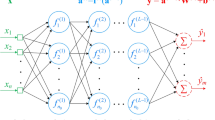Abstract
Compared with other feed-forward neural networks, radial basis function neural networks (RBFNN) have many advantages which make them more suitable for nonlinear system modeling, and they have recently received considerable attention. In this paper, a RBFNN is employed to model strongly nonlinear systems. First, the problems of nonlinear system modeling are analyzed, and then the structure of the RBFNN as well as the training algorithm are improved to solve these problems. Finally, an industrial high-purity distillation column, which is a strongly nonlinear system, is successfully modeled with the improved RBFNN. Owing to the complexities of a nonlinear system, it is necessary to use a real-time model correction method to modify the parameters of the RBFNN model in real time. One efficient method is proposed in this paper. The idea is to employ the Givens transformation to modify the parameters of the RBFNN-based model.
Similar content being viewed by others
Explore related subjects
Discover the latest articles, news and stories from top researchers in related subjects.References
Chen S, Cowan CFN, Grant PM (1991) Orthogonal least squares learning algorithm for radial basis function networks. IEEE Trans. Neural Networks 2(2):302–309
Chen S, Grant PM, Cowan CFN (1992) Orthogonal least squares algorithm for training multioutput radial basis function networks. IEE Proc-F 139(6):378–384
Moody J, Darken C (1989) Fast learning in networks of locally tuned processing units. Neural Comput 1:281–294
Bianchini M, Frasconi P, Gori M (1995) Learning without local minima in radial basis function networks. IEEE Trans. Neural Networks 3:749–755
Girosi F, Poggio T (1990) Networks and the best approximation property. Biol Cybernetics 63:169–176
Kung SY (1993) Digital neural networks. PTR Prentice-Hall, Englewood Cliffs
Xu L, Krzyzak A, Oja E (1993) Rival, penalized competitive learning for clustering analysis, RBF net, and curve detection. IEEE Trans. Neural Networks 4(4):636–649
Holcomb T, Morari M (1993) Local training for radial basis function networks: Towards solving the hidden unit problem. American Control Conference, 1993, pp. 2331–2335
Chen S, Billings SA, Grant PM (1992) Recursive hybrid algorithm for nonlinear identification using radial basis function networks. Int J Control 55(5):1051–1070
Wang X, Luo R, Shao H (1996) Designing a soft sensor for a distillation column with the fuzzy distributed radial basis function neural network. Proceedings of the 35th IEEE Conference on Decision and Control, Kobe, Japan, December 11–13, 1996, pp 1714–1719
Wang X (1997) The radial basis function neural network and its applications to process control. PhD dissertation, Shanghai Jiao Tong University
Gentleman WE (1973) Least squares computations by Givens transformations without squares roots. J Inst Math Appl 12:329–336
Author information
Authors and Affiliations
Corresponding author
About this article
Cite this article
Wang, X., Ding, Y. & Shao, H. The improved radial basis function neural network and its application. Artificial Life and Robotics 2, 8–11 (1998). https://doi.org/10.1007/BF02471145
Received:
Accepted:
Issue Date:
DOI: https://doi.org/10.1007/BF02471145




